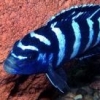Pseudotropheus demasoni
Variants
It is debatable whether there is a difference between fish from Pombo Rocks and Ndumbi Reef. It is not visible on the copies I've seen.
General Description
In the wild:
Males and females create feeding territories from and on the rocks at Pombo Rocks and Ndumbi Reef, which are the only places the species found. There are no special breeding territories as is often seen in other Mbuna. Females live, however, more withdrawn than the males.
In the aquarium:
This is one of the fish it is hard to get around if you make a Mbuna aquarium! It can go along with virtually all other Mbuna, regardless of size, and I know you have never heard of, that they have entered into hybrids. Demasoni `is very confident, and can not touch the fish have no specific able to swallow them, and even then ensure their incredible speed that they usually get away with fights with opponents who are many times larger than themselves. This does, of course, that the interests of the other fish shall ensure that there is enough room in the tank, and it's a good idea to make sure plenty of hiding places. If you have the chance, it's very best to keep a bunch, possibly. in an aquarium for itself, as it provides optimal opportunities to experience the interrelationship game is between the individuals when they are not disturbed.
There is a myth among aquarists who go out on that you can not keep demasoni and Saulosi in the same tank because males are too similar, and will fight. It is not something that has nothing on it, I know up to several, including myself who have had the two species together, and it gives neither more or fewer fights.
A little history:
Demasonien is one of the newest species in the hobby, and is already a classic! The first specimens we saw at home was traded to the staggering rates (in the mid 90 `s to the $ 500 per. Pair). This led to some concern that they would be destroyed due the strictly limited propagation area and the heavy demand, but it turned out happily to demasoni `an almost impossible to stop MHT propagation, and there are now probably over 1000 aquarium specimens for each lost, and the pressure is eased, with the price has collapsed, so they are now to buy for $ 8 / per fish. in farming, while a wild collected pair typically costs about. $ 85.
Breeding Behaviour
Breeding Behaviour
Maternal mouthbrooder. Typical Mbuna, males have a territory where they entice females to play. It takes 3 weeks before the offspring is let out. The kids are small copies of the adult and can live on the same food as the adults from the start, but you can help them a little on the road by pulverizing it. They are good at taking care of themselves. If you want to raise as much as possible, the female is taken from about 18 days after the play, and placed in a separate tank.
Number of offspring
5-20
Info
Type
Cichlider, Malawi - Mbuna
Trade Name
Demasoni
Described
Konings 1994
Cichlider, Malawi - Mbuna
Trade Name
Demasoni
Described
Konings 1994
Looks
Colours
The base color is black with luminous sky blue stripes. Sexes are similar, but dominant males are more intense in color.
Size Male
9
Size Female
7
Variants
It is debatable whether there is a difference between fish from Pombo Rocks and Ndumbi Reef. It is not visible on the copies I've seen.
The base color is black with luminous sky blue stripes. Sexes are similar, but dominant males are more intense in color.
Size Male
9
Size Female
7
Variants
It is debatable whether there is a difference between fish from Pombo Rocks and Ndumbi Reef. It is not visible on the copies I've seen.
Best Conditions
Min. temp
24°C
Max. temp
28°C
Min. pH
7.6
Max. pH
8.5
Min. aquarium
250L
Holding!;
Best with More Females then Males
24°C
Max. temp
28°C
Min. pH
7.6
Max. pH
8.5
Min. aquarium
250L
Holding!;
Best with More Females then Males
Food
Food:
Algies
Cichlidsticks
Cyclops
Flakes
Schrimpmix
Spirulina
Edited by Malawi Freak, 03 June 2013 - 11:15 PM.
















